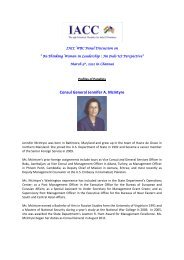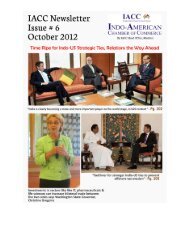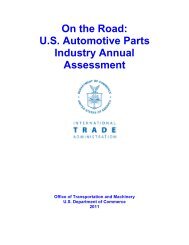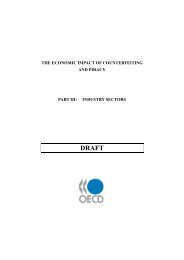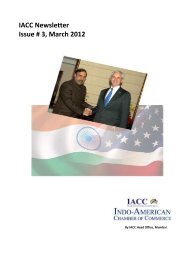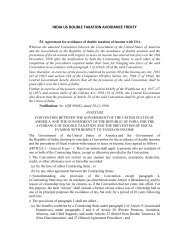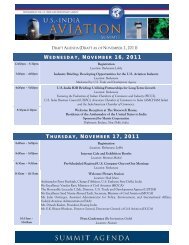Download the PDF version here - Indo-American Chamber Of ...
Download the PDF version here - Indo-American Chamber Of ...
Download the PDF version here - Indo-American Chamber Of ...
Create successful ePaper yourself
Turn your PDF publications into a flip-book with our unique Google optimized e-Paper software.
web to provide long-distance education. T<strong>here</strong>'s also some interest in <strong>the</strong> United States to build entire<br />
campuses in India, though officials say that is ra<strong>the</strong>r muted at this moment.<br />
The Obama administration is providing a total of $250,000 in grants initially to U.S. institutions<br />
interested in sending representatives to India to lay <strong>the</strong> groundwork for substantive partnerships. The<br />
administration hopes <strong>the</strong> U.S.-India higher-education partnership will eventually streng<strong>the</strong>n into a $10<br />
million effort, provided <strong>the</strong> U.S. Congress approves of <strong>the</strong> expenditure.<br />
Meanwhile, two universities from New Jersey, a state with a heavy Indian expatriate population, are<br />
hoping to become pioneers who lead <strong>the</strong> rest into <strong>the</strong> new <strong>Indo</strong>-U.S. higher education frontier.<br />
Rutgers University began working on a joint program with <strong>the</strong> Tata Institute of Social Sciences in<br />
Mumbai more than a year ago. David Finegold, a Rutgers vice president, said faculty members from his<br />
university are working with Tata researchers to help India effectively educate more of its college-age<br />
citizens and move beyond churning out a relatively small number of highly trained, English-speaking<br />
graduates proficient in high-tech fields.<br />
Rutgers faculty are also helping Indian officials plan for a national vocational university to train students<br />
for blue-collar careers. NJIT is in <strong>the</strong> early stages of establishing a focused master's level program for <strong>the</strong><br />
employees of one global technology company begun by an Indian expatriate - a different model than <strong>the</strong><br />
inter-university links envisioned under <strong>the</strong> U.S.-India higher education partnership.<br />
The NJIT program, set to begin this spring, will offer a 12-credit graduate program to <strong>the</strong> employees of<br />
<strong>the</strong> NeST Group in Kochi and Thiruvananthapuram. NeST founder Javad Hassan said that his employees<br />
will receive <strong>the</strong> same rigorous education that students at NJIT's Newark campuses receive.<br />
The NJIT program marks a different experiment, one that bypasses <strong>the</strong> governments of India and <strong>the</strong><br />
United States. Hassan said <strong>the</strong>re may be no need for government involvement given <strong>the</strong> technological<br />
linkages already present between <strong>the</strong> two countries.<br />
The NJIT program, he added, is designed to teach his employees not just advanced technical skills but<br />
also soft skills such as <strong>the</strong> ability to communicate effectively and work collaboratively across cultures.<br />
Those soft skills are increasingly valuable - and something U.S. universities are uniquely equipped to<br />
teach Indian students, according to Sam Pitroda, an adviser to Indian Prime Minister Manmohan Singh.<br />
Speaking at a conference on <strong>the</strong> Indian higher education system organized by Penn State last October,<br />
Pitroda outlined a litany of problems that <strong>the</strong> Indian government is trying to address within <strong>the</strong> next few<br />
years:<br />
• Raising <strong>the</strong> quality of instruction at Indian institutions;<br />
• Promoting world-class research by Indian faculty members;<br />
• Getting professors to teach students to be creative problem solvers ra<strong>the</strong>r than stressing rote<br />
memorization of facts and figures;<br />
• Making it possible for more of India's poor to gain higher education.<br />
"We believe <strong>the</strong> next three to five years are going to be critical for us to focus on expansion, excellent<br />
and equity," Pitroda told <strong>the</strong> U.S. university officials in attendance, seeking <strong>the</strong>ir help. "We need to<br />
really design better models for cooperation. We need to link universities <strong>here</strong> to universities <strong>the</strong>re, not<br />
only to top-tier, but also second-tier and third-tier cities."<br />
But Pitroda also pressed for prompt action from <strong>the</strong> U.S. side. "We need concrete programs," he said.<br />
"O<strong>the</strong>rwise we'll have more conferences like this and won't be able to translate programs (into)<br />
execution."








